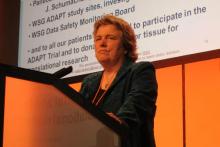SAN ANTONIO – Twelve weeks of trastuzumab emtasine as single-agent neoadjuvant therapy in HER2-positive/hormone receptor–positive early-stage breast cancer achieved a pathologic complete response rate of 41%, underscoring the feasibility of therapeutic de-escalation in that patient subgroup, according to Dr. Nadia Harbeck.
Dr. Harbeck, head of the breast center at the Technical University of Munich, presented the final analysis of the phase II, 376-patient WSG-ADAPT HER2+/HR+ (Women’s Healthcare Study Group–Adjuvant Dynamic Marker–Adjusted Personalized Therapy HER2+/HR+ trial). The primary finding: The pathologic complete response (pCR) rate in the breast and lymph nodes after 12 weeks of neoadjuvant therapy with no systemic chemotherapy in this three-armed trial was 41% with trastuzumab emtasine (T-DM1) alone at 3.6 mg/kg every 3 weeks, 41.5% with T-DM1 plus endocrine therapy, and just 15.1% with tamoxifen plus endocrine therapy.
Adding in those patients with a near-pCR – that is, patients who were ypT1a, with very little remaining tumor burden of dubious clinical significance – the results looked even stronger: a pCR/near-pCR rate of 53% with neoadjuvant T-DM1 alone and 52.9% with T-DM1 and endocrine therapy, versus 19.3% with trastuzumab plus endocrine therapy, Dr. Harbeck said at the San Antonio Breast Cancer Symposium.
Thus, adding endocrine therapy to T-DM1 (Kadcyla) didn’t improve upon the effectiveness of T-DM1 alone in this updated and final WSG-ADAPT analysis. That’s an important difference from an earlier 130-patient prespecified interim analysis Dr. Harbeck presented at the 2015 ASCO meeting. At that point it seemed – incorrectly, as it turned out – that concurrent endocrine therapy and T-DM1 provided added benefit in premenopausal but not postmenopausal women.
“Single-agent T-DM1 therapy warrants further evaluation in early breast cancer, not just because of the efficacy, which I think is very impressive, but also because of the favorable safety profile,” she said.
Mild to moderate constipation, thrombocytopenia, dry mouth, fatigue, arthralgia, headache, and hot flushes were roughly twice as common in the combined T-DMI and T-DMI plus endocrine therapy arms, compared with the trastuzumab plus endocrine therapy arm. But the only grade 3 adverse event that was more frequent in the two T-DMI study arms was an elevation in liver enzymes, which occurred in 4.1% of those patients and none on trastuzumab and endocrine therapy.
WSG-ADAPT is actually an umbrella trial that to date has enrolled about 4,000 patients. An important goal of ADAPT is to identify and validate useful early biomarkers of clinical response. WSG-ADAPT HER2+/HR+ assessed two: a drop in Ki67 of 30% or greater or low cellularity as defined by fewer than 500 tumor cells in the biopsy taken at the 3-week point in neoadjuvant therapy, after one cycle of treatment had been completed. Patients with either marker of early response proved to be 2.2-fold more likely to have a pCR than women in whom the early biomarkers were absent.
Dr. Harbeck argued that the ADAPT findings make a cogent case for changing the current standard of care in treating HER2+ early breast cancer, which is chemotherapy plus anti-HER2 therapy regardless of the malignancy’s hormone receptor status.
“We don’t adjust for hormone receptor status in our standard treatment today, even though we know hormone receptor–positive disease is a distinct entity,” she said.
The study was sponsored by Roche. The presenter serves as a consultant to Roche, Celgene, and Genomic Health.


